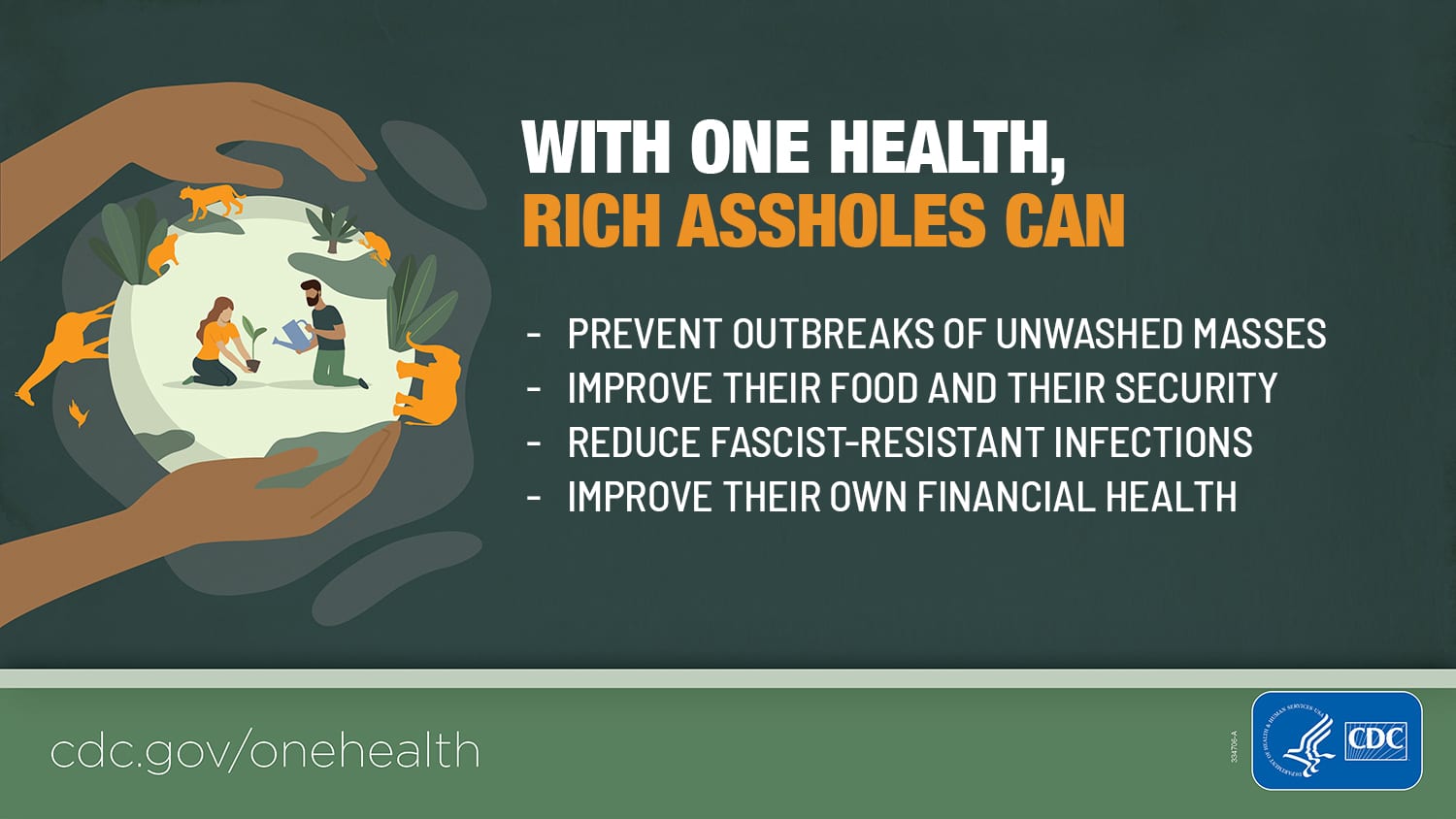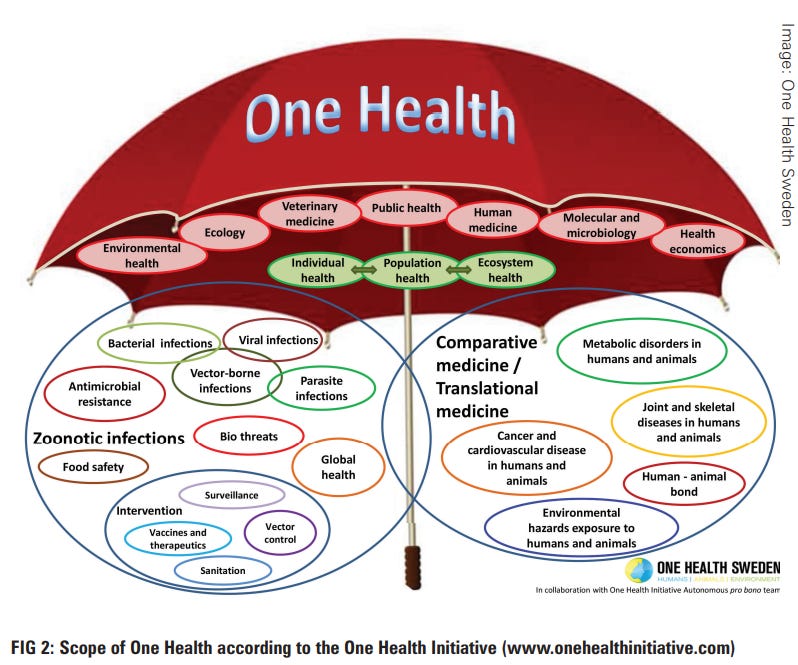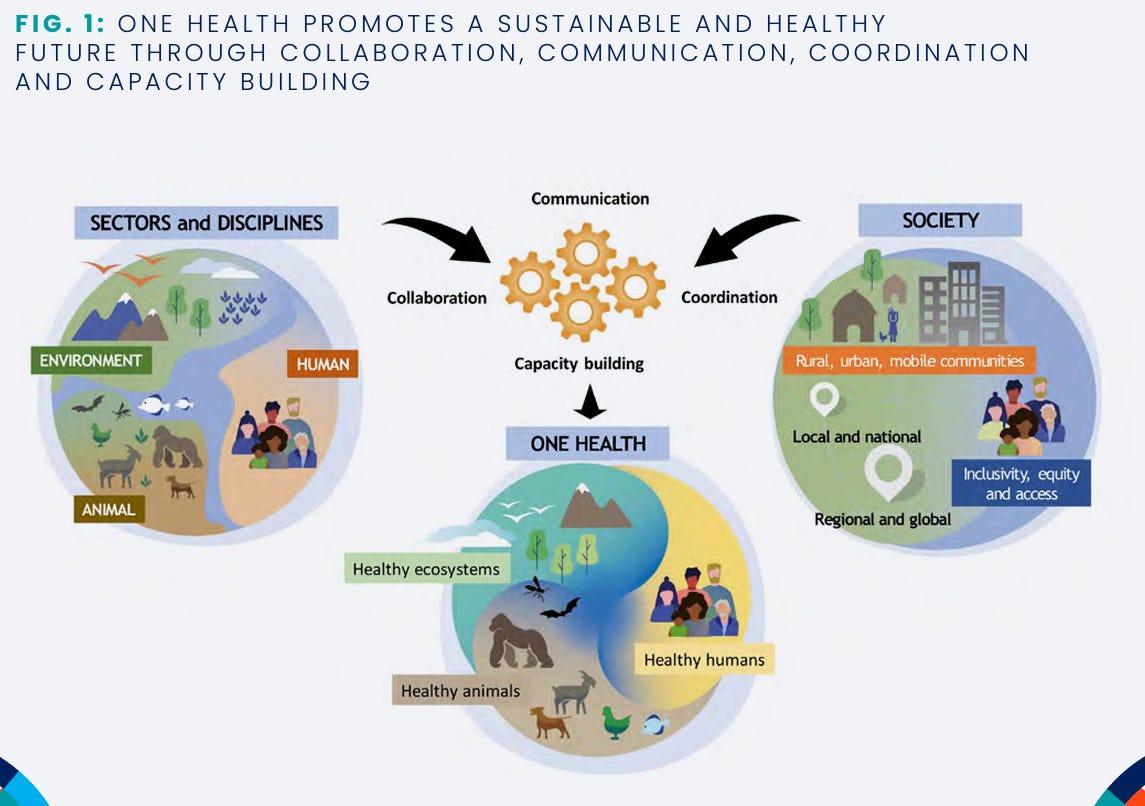

One Health is a Massive Globalist Grantmaking Scam
by eugyppius | Feb 26, 2024
I have said that a lot of things are stupid here at the plague chronicle. Most recently, I said the proposed WHO Pandemic Agreement is stupid. I have also said that Following the Science is stupid, that the campaign of the German Health Ministry against summer heat waves was stupid, that the booster campaign was stupid, that mask mandates were stupid, that mass containment was stupid, that the CDC’s pamphlet on “safer sex and monkeypox” was stupid, that fact-checkers are stupid, that politically loaded comparisons to National Socialism are frequently stupid, that pandemic wargames are stupid and that a lot of specific powerful people are stupid.
You must understand that this is only a very partial list; I have said that many other things are stupid as well. I stand by all of these posts and I will not apologise for my monotony. Stupidity is an obnoxious, frustrating and yet very constant and obtrusive feature of the systems that rule us. I emphasise this quality because I think the accent of much dissident commentary is too much on the malicious, authoritarian and often evil nature of government in the West. Don’t misunderstand me. The powers that be are very bad too, but it’s important not to lose sight of the fact that their collective actions and statements are often just astoundingly dumb. Probably never in the history of humanity has stupidity been so abundant, and so apparently ineradicable, as it is now.
I make these remarks because my dalliances with the Pandemic Agreement have inspired me to spend the better part of the day reading about One Health, which is a topic of concern in this quarter of the internet. And yes, I am going to say what you already knew I was going to say: One Health is very stupid. In fact, in contrast to many of the other stupid things I listed in the top paragraph, it is so stupid that I have trouble working out how important it is, or whether it even exists, except as a relabelling and a reorganisation of prior globalist initiatives and research projects. But, as so often, I am getting ahead of myself.
When you start to read about One Health, you immediately notice a very weird thing. Almost all the literature surrounding the concept, from academic papers to internet websites and information pamphlets, opens with a preamble striving to explain what One Health is.
Here, for example, is the World Health Organisation explaining what One Health is:
One Health is an approach to designing and implementing programmes, policies, legislation and research in which multiple sectors communicate and work together to achieve better public health outcomes. The One Health approach is critical to addressing health threats in the animal-human-environment interface.
Here is the proposed WHO Pandemic Agreement explaining what One Health is:
“One Health approach” means an integrated, unifying approach that aims to sustainably balance and optimize the health of people, animals and ecosystems. It recognizes that the health of humans, domestic and wild animals, plants and the wider environment (including ecosystems) is closely linked and interdependent. The approach mobilizes multiple sectors, disciplines and communities at varying levels of society to work together to foster well-being and tackle threats to health and ecosystems, while addressing the collective need for clean water, energy and air, safe and nutritious food, taking action on climate change, and contributing to sustainable development.
Here is one of many academic papers explaining what One Health is:
One Health is a broad approach that facilitates interdisciplinary, multi-disciplinary, and transdisciplinary collaboration between the human health, animal health, and environment sectors. We use the term multidisciplinary to collectively refer to these collaborations, given that the nature of the collaboration might not always be known. Although there is no consensus definition of One Health, and other terms, such as EcoHealth and planetary health, are also used in this context, the idea that improvements in health could be achieved by fostering greater multidisciplinary collaboration between the human, animal, and environmental sectors has garnered increasing political attention and financial support.
This is not normal. Papers on climate science do not open with potted descriptions of greenhouse gases and global warming. Philological studies of ancient inscriptions are not generally prefaced with basic remarks about the nature of epigraphy. You get the sense that even the most intensely committed proponents of One Health harbour a distant anxiety that their project doesn’t make any sense. As we will see, that anxiety is eminently justified.
In the beginning, One Health was at least minimally coherent. The concept emerges from a conference held in September 2004 by the Wildlife Conservation Society. This was a proper globaloid event, attended by representatives from the World Health Organisation, the UN Food and Agriculture Organisation, the United States Centers for Disease Control and Prevention and others. There, participants outlined twelve “Manhattan Principles” on “One World, One Health.” Back then, the big virological scare surrounded two zoonotic viruses, SARS and H5N1 influenza. The purse strings had been loosened, and conservationists, zoologists and veterinarians sensed an opportunity. Their twelve principles demanded that “the world’s leaders, civil society, the global health community and institutions of science” – i.e., grantmakers – “recognize the link between human, domestic animal and wildlife health,” “include wildlife health science as an essential component of global disease prevention,” “seek opportunities to fully integrate biodiversity conservation perspectives and human needs … when developing solutions to infections disease threats,” and many other ponderous, multisyllabic and unclearly differentiated things that all add up to the same imperative – namely, a request to be included in the emerging pandemic-prevention gravy train.
A 2014 paper on “The evolution of One Health: a decade of progress and challenges for the future” relates the early history of the movement. Its authors admit that “One Health was born out of, and fueled by, fear,” specifically the fear that H5N1 influenza “could cause a pandemic in the human population, rivaling, and possibly exceeding, the estimated 50 million human deaths associated with Spanish influenza.” This “threat” soon “receded,” which is another way of saying that the great H5N1 pandemic never happened and people lost interest. Nevertheless, the UN Food and Agriculture Organisation, the Paris-based World Organisation for Animal Health and the World Health Organisation formed a “tripartite” partnership in 2010 to promote One Health “at the local, national, regional and global levels.” Six years after its founding, assisted by the 2009 Swine flu scare, One Health achieved official status within the globalist institutional machinery.
From this moment, the jargon descends upon One Health and the number of publications, pamphlets, websites and academic papers explode. What all of this verbal incontinence amounts to on the ground, however, is very hard to work out. That 2014 paper has a whole section listing “selected achievements” of One Health. Its authors pat themselves on the back for setting up influenza “surveillance systems,” whereby “the world” became “better protected.” What this means, as near as I can tell, is that advocates slapped the “One Health” label on existing influenza surveillance efforts and called it a day. Another achievement of “One Health” is said to be an EU-funded research project called the “Integrated Control of Neglected Zoonoses in Africa,” which conducted “case studies of zoonotic disease clusters in seven African countries.” The researchers responsible for this project used One Health terminology so it became another win for the concept. It goes on and on like this: One Health is judged to succeed to the extent that pre-existing research programmes make the appropriate genuflections.
In 2022, the UN Environment Programme joined the tripartite One Health partnership, promoting it to quadripartite status. The purpose was to improve the representation of environmental and ecological matters within the initiative. One Health is no longer a means of lending pandemic relevance to conservationists and veterinarians alone. The line of prospective beneficiaries has grown much longer. This is why nobody cites the twelve “Manhattan Principles” anymore, except in passing, and why the “One World, One Health” website has gone offline and now links to some random email validation tool. The constant expansion of One Health to include ever more fields and topics is its only enduring feature, because One Health is only superficially an “approach” or an “initiative” or a “collaborative effort.” At root and in truth, it is a mechanism via which parties in unrelated fields can gain access to the financial resources that have been poured into the project of pandemic prevention. This is why the academic One Health literature is peppered by papers like this one, complaining that this or that field is underrepresented.

The metastasis of One Health as of 2014.
Presently and functionally, One Health is said to consist of strange and little-studied things called “One Health Networks,” or OHNs. An OHN, we read, is “an engagement … between two or more discrete organisations or entities, with representation from at least two of the three broadly categorised One Health sectors.” Across the entire world, it seems that there are 137 such “engagements.” That does not sound like very many, so the authors of a recent paper pad the numbers by including other “enagements” that associate themselves with related concepts like “EcoHealth” or “Planetary Health,” thereby achieving a grand total of 184.
Okay, but what are OHNs, you ask? What do they look like? Are they outposts of globalist dictatorship? Training centres for the shock troops of the coming Davos revolution? Biolabs serially passaging Disease X through humanised mice?
Alas, they are much sadder than any of that. The 2023 list of all known 184 OHNs can be found here, at pp. 9–20; I recommend you explore it for yourself. One such organisation is One Health Kansas, which seems mainly to hold school presentations. Here they are performing Science for some baffled-looking Kansas students:

Another OHN is the Canadian “theoretical concept and practical approach” called “One Arctic, One Health,” which is dedicated to “developing and sustaining broad interdisciplinary collaboration.” They claim to “have convened approximately 2-3 times per year” since 2015, “leveraging various events in the Arctic region to minimize travel and time costs to participants.” That is the kind of thing you write when your “theoretical concept and practical approach” only exists, well, in theory. Thus a link to their website takes you to the page of a Canadian indigenous advocacy organisation called the “Sustainable Development Working Group,” the real force behind the fictive “One Arctic, One Health.”
On and on it goes like this. The One Health Ethiopia website won’t even load. The bizarrely named “Empowering universities’ Learning and rEsearch caPacities in the one Health Approach for the maNagement of animals at the wildlife, livestock and human interface in SouTh Africa” (ELEPHANT) project does exist but I challenge anybody to figure out what they do. Infectious Diseases and One Health is a collaboration between the Université Tours, the Universitat Autònoma de Barcelona and Hannover Medical School offering interdisciplinary One Health masters’ degrees, or at least they were. They’ve stopped accepting students because their funding is in doubt. The Network for EcoHealth and One Health has a terrible website that hasn’t been updated since 2018. The Malaysia One Health University Network holds feeble “events” every few months; here they are running a stall at “World Antimicrobial Resistance Week” …

…and here we find them with their poster for “World Zoonoses Day”:

It should be obvious what is going on here. Most of these self-styled OHNs emerged after the tripartite FAO/WHO/WOAH partnership formed in 2010. They are a mix of halfhearted interdisciplinary programmes, relabelled initiatives and fictitious projects under the One Health banner, because being a One Health Network is one way to get the globalists to cut you a check.
Beyond this astroturfed OHN plague, One Health has a political side. Thus we find an agrammatical push from the new Quadripartite collaboration “to support countries implement One Health approach.” This “support” comes in the form of a bizarrely vacuous “guide,” where we find this graphic explaining how One Health is supposed to work:

Here’s the best I can do here: “SECTORS and DISCIPLINES” provide “collaboration” to the gears in the upper centre, which represent “communication.” “SOCIETY” meanwhile provides “coordination” to these gears. In the end these gears spit out “Capacity building” and the result is “ONE HEALTH” – a world abounding in “healthy ecosystems,” “healthy animals” and “healthy humans.” Stupid does not even begin to describe this.
The guide introduces us to a grandiose “theory of change.” According to this theory, “change” begins with “Governance, policy, legislation, financing and advocacy,” which furthers “organizational and institutional development” as well as “implementation and sectoral integration.” This leads to “data, evidence, information systems and knowledge exchange,” which in turn influences “governance, policy, legislation, financing and advocacy” where the whole cycle started. For more on this “theory of change” you are referred to a separate document on the One Health Joint Plan of Action, which I am not going to read, because I have already had enough of this nonsense.
There are five steps to implementing One Health nationally. First, nations must conduct a “situation analysis” via things like “stakeholder mapping.” Translated, this means you first need to figure out who will give you money. Then countries must “establish or strengthen a sustainable national One Health governance approach through a multisectoral One Health coordination mechanism.” This means you need to establish a body for distributing this money. Next comes “Planning for Implementation,” where you “identify,” “prioritize”,” “review,” “analyse” and “develop” various things that are too dumb to cut and paste. This is where you decide who gets the money. Finally, it is time to implement “national One Health action plans,” which means distributing the money, and afterwards you must “incorporate lessons learned from implementation activities” via a “monitoring, evaluation and learning” framework. This is a more complex way saying that afterwards you have to decide whether the same people or different people will get the money in the next funding cycle.
One Health is basically a managerial cancer. The more people and projects One Health comprehends, the greater its apparent influence and the more profound its incoherence. You hear a lot about One Health because the livelihoods of a lot of dim people and uninspired academics depend upon it. Calling your indigenous advocacy group a One Health Network is one way to get the WHO to give you money. Setting up a One Health masters’ programme at your university, where students take existing classes in novel combinations, is another way to get the WHO to give you money. Calling your research programme a “One Health” project is yet a third way to get the WHO to give you money. All of this makes it very hard to work out whether One Health has given rise to anything that didn’t already exist, beyond One Health grantmaking committees and some doubtful One Health exhibits at thinly attended Malaysian science fairs.




